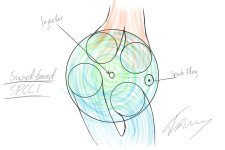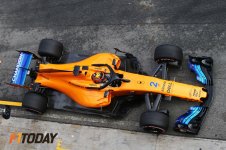Soldato
You are using an out of date browser. It may not display this or other websites correctly.
You should upgrade or use an alternative browser.
You should upgrade or use an alternative browser.
F1 Testing 2018: Week 1 Barcelona (26th - 1st)
- Thread starter Shimmy
- Start date
More options
Thread starter's postsSoldato
Nope, that's the actual tyre size!
Associate
Lap times falling now. Hamilton just did a 1:19.333 on the medium, which is 2 tenths slower than pole last year on the soft (2018 medium is pretty much 2017s soft). Hard to say what the resurfacing has done to times though.
Soldato
They still need to make the driver numbers more obvious, even more so now that the Halo is obscuring the helmet.
Soldato
So I'm aware it's only testing, but Sirotkin 10 seconds behind Stroll? Did I miss something glancing over that or is he really that far behind the pace?
I'm not sure on this, but it was wet in the morning, so maybe Sirotkin did the morning session when they were running intermediates.
Soldato
Sirotkin never got to run a dry tyre.
Soldato
Deleted member 651465
D
Deleted member 651465
Link the videos, they never work embedded.
Soldato
Honda has a interesting new sound this year.
Honda has a interesting new sound this year.
Could be spark or fuel cut while sitting stationary to lower heat or something?
Soldato
Could be spark or fuel cut while sitting stationary to lower heat or something?
This got posted to Reddit trying to explain:
Technically hypothesis : Credit to Glenntws at f1techncial: [PT1]
Now, the sound of the new engine in idle is veeery interesting in my opinion because it actually gives out much information about what philosophy Honda uses for combustion (at least that's what I think). After analyzing the idle sound in Audacity for a bit, I came to the conclusion the the firing order has been changed, at least I'm somehow sure of that because the behaviour is very different, much smoother than before, the ignition pattern seems extremely even. I can't post a screenshot because masking all the parts would simply take to long (maybe I will do it later), but it seems to me that the engine is running on 3 cylinders in idle, keeping them firing for 4 turns and then shutting of the ignition for 4 turns. After a while, they seem to swap the active cylinders and do the exact same process (that's why there's a short pause in the sound).
This sounds very crazy but I actually think this is a extremely big hint to the combustion process. First, the swapping of the active cylinders is normal when doing cylinder shutoff because you want to keep the engine warm evenly so that really is no wonder in my opinion. What makes me going crazy is the actual shutoff of the complete engine for 4 turns, because it makes me think that the combustion process is highly dependent on the intake velocity and the overall air velocity in the cylinder.
Sounds weird first but it makes perfect sense. If Honda goes to low on the throttle, the velocity and pressure in the intake is lower than ok for the combustion process they use. That's why they play through 3 cylinders for 2 times with a relatively high amount of throttle (for idle) and then keep them turned of for 2 times to hold a steady rpm at idle.
Why would Honda need to do this?
Well a couple of pages ago I think roon made some interesing sketches promoting the usage of a swirl dependent combustion process. This idea hasn't left me alone. So here's comes my interpretation of a swirl dependent SPCCI-ICE.
- There is NO pre-chamber.
- One injector and one spark plug. The positions of both however is pretty variable in this concept so my arrangement is just for demo purposes.
- The air near the cylinder wall is the main ignition source. A big chunk of lean air in the center of the engine is the main power source.

Remember that this idea is not worked out very well, it's just a idea that in my opinion fits to the current things known about the engine and the fact that this year's combustion process is very different according to Wazari.
So think about it that way. The intake valves and ports are arranged and designed in a way that promotes a extremely huge amount of swirl on the outer boundaries of the chamber near the walls. The charge in the center of the cylinder of course also achieves a pretty big amount of swirl but the velocity is nowhere near to the velocity of the air at the outer boundaries. Now during intake and compression, the air inside the complete cylinder gets enriched with fuel but to a pretty lean level. This charge would barely ignite on it's own, especially not under high rpm's.
The trick is with a second injection phase very shortly before the ignition point. A very pointed spray of fuel gets' sprayed in the direction of the outside chamber. The amount off added fuel to the center is very low in comparison and with good pre calculations the AF-ratio can still be kept very low in the center. The little amount of fuel raises the charge at the walls above the neccessary AF-ratio for ignition. A spark plug near the wall now ignites this charge which in turn (because of the violent swirl) reaches the complete wall in a very short amount of time. The charge pressure in the center of the cylinder now get's extremely hot and dense because of the fire ring around it.
This extremely high pressure is more than enough to let the charge in the center of the cylinder ignite in a way very similar to HCCI.
With good design and calculation, the amount of richer fuel on the walls can be kept very low, allowing for a overall very lean charge in the cylinder.
Now, why is this so velocity dependent? The problem with this concept is the huge dependency on the swirl. If the velocity and density of charge in the cylinder is not high enough at the cylinder walls, the fire ring will not be established fast enough and many not wanted this could happen. The charge in the center could ignite in a pattern which is not going well with some parts of the head or piston (pressure-wise) or the charge may not even ignite at all because the pressure in the cylinder is simply to low to keep this combustion process alive. Running the engine under very low load would require a very rich charge near the wall and a at least stochiometric charge in the center and the whole efficiency thing is gone.
Also with a too high amount of fuel near the walls you promote the washing out of oil which of course is not good for the engine. A slightly rich fuel mixture near the cylinder wall however would not do so much damage and the huge amount of swirl would even promote the pick-up of oil particles at the wall which could help with the ignition of the outer charge (there's your possible source of oil consumption).
So, these were my ideas for the current engine. Not a very refined sketch from me and surely not thought out to the end but definetly "doable".
Soldato
That is quite an interesting concept there. I do hope that Honda get their act together this year though.
Soldato
Sounds like my old Kawasaki 2 stroke triple on idle..
Honda has a interesting new sound this year.
3 chickens... Cluck cluck cluck
Caporegime
Honda has a interesting new sound this year.
It's definitely doing something strange while idling, isn't it? I guess F1 cars idle so little that it makes sense to design them around what they do when they're going and just ensure they can idle at all.
Soldato
I don't know how they did the first part of the video - they're constantly playing dire music in the main straight stand!
All the engines are louder again this year, and Mercedes are the loudest - Force India sounded like they topped the field. The noise is less directional than it was when the V6 was first reintroduced, but it is still very quiet on approach. We're not back to the V8 days, but you'd now soon be reaching for the earplugs if you were repeatedly facing the exhausts. The noise in the main straight stand is deafening, without being distorted. Two or more cars passing by at full throttle and you cannot hold a conversation. It is actually a really nice balance compared to the old V8s.
All the engines are louder again this year, and Mercedes are the loudest - Force India sounded like they topped the field. The noise is less directional than it was when the V6 was first reintroduced, but it is still very quiet on approach. We're not back to the V8 days, but you'd now soon be reaching for the earplugs if you were repeatedly facing the exhausts. The noise in the main straight stand is deafening, without being distorted. Two or more cars passing by at full throttle and you cannot hold a conversation. It is actually a really nice balance compared to the old V8s.


